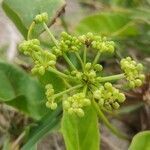Stems filiform, creeping; lvs orbicular, peltate, to 6 cm, commonly with 8–14 shallow lobes; infl (except in depauperate plants) a simple or once to thrice forked spike to 15 cm or even more, bearing 2–several whorls of fls, these rarely more than 7 per whorl; fr 3–4 mm wide, truncate to rounded at base, the margins acute. Mass. to Fla. and Tex., chiefly near the coast; w. U.S. and trop. Amer. June–Aug. Typical H. verticillata has the fls and frs sessile or subsessile. Plants with distinctly pedicellate fls and frs, the pedicels to 1 cm, occur over the same range and have been called var. triradiata (A. Rich.) Fernald. (H. canbyi; H. australis)
Fruit 2 × 4 mm., reddish-brown, laterally flattened, broadly ellipsoid, base cuneate, pedicel 1 mm. to obsolete; apex broadly and shallowly emarginate, stylopodium depressed to almost obsolete, styles short and spreading. Fruit ribs well developed, commissure scarcely depressed.
Inflorescence an interrupted verticillate spike, approximately equal in length to the subtending leaf (axis occasionally branched to produce 2 or more parallel spikes).
Flowers small, inconspicuous, 2–7 in each verticil, initially closely packed together, the axis only expanding to separate the verticils as the fruit begins to mature.
Creeping perennial rooting at nodes, stems to 30 cm. Leaves peltate, margins crenate. Flowers whorled in interrupted spikes, white. Fruits depressed-globose.
Lamina up to 45 (60) mm. in diameter, circular to broadly elliptic, with 8–13 main veins radiating from the petiole; margin shallowly crenately lobed.
Creeping herb, glabrous. Leaves shallowly crenately lobed, peltate. Inflorescence an interrupted spike. Flowers white to greenish yellow.
Glabrous creeping herb, rooting freely at the nodes; stems delicate, terete, brownish-white.
Leaves peltate, on long petioles up to 15 cm.








